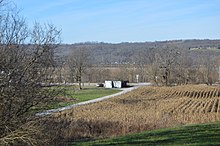Burley (tobacco)
The origin of white burley tobacco was credited to George Webb and Joseph Fore in 1864, who grew it on the farm of Captain Frederick Kautz near Higginsport, Ohio, from seed from Bracken County, Kentucky.
In the U.S., burley tobacco plants are started from pelletized seeds placed in polystyrene trays floated on a bed of fertilized water in March or April.
Producers must contend with major diseases, such as black shank and blue mold, and insects including aphids, tobacco hornworms, and budworms.
Plants are topped by removing the developing flower head roughly 60 days from transplanting, and treated to prevent the growth of side shoots called suckers.
Suckers grow vigorously immediately after topping and can severely reduce yield and quality if not effectively controlled.
[3][4] As a result, a broad ban enacted by Canada and proposed in many other countries would block the import of nearly all tobacco products containing burley.



